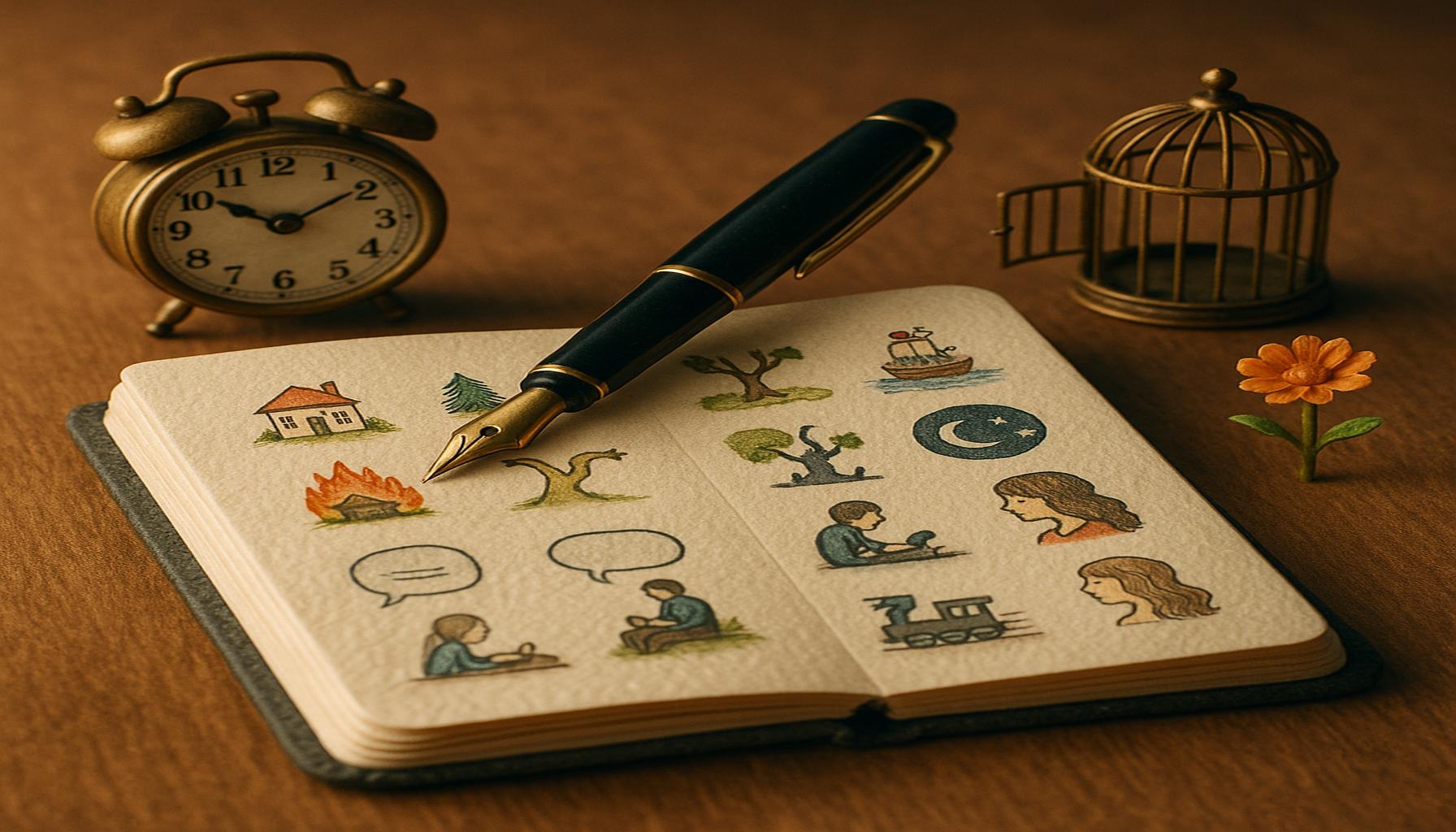The Art of Microfiction: Telling Stories in Few Words

Unveiling the Power of Brevity
Microfiction is a remarkable literary form that captures profound narratives in just a few words. In a world where attention spans are fleeting, this art allows writers to engage readers quickly and impactfully. It challenges the traditional boundaries of storytelling, proving that less can indeed be more. The inherent conciseness of microfiction creates a unique space for creative expression, where every word is meticulously selected to convey depth and emotion.
Why Microfiction Matters
Microfiction isn’t just a passing trend; it reflects our modern lifestyle. With the rise of smartphones and social media, readers often seek quick, digestible content. This shift has led to a resurgence in microfiction’s popularity. Here are some compelling reasons why this format is gaining traction:
- Accessibility: Microfiction’s brevity makes it easy for readers to enjoy stories on-the-go, whether during a coffee break, while commuting, or waiting in line. This aligns perfectly with our hectic schedules, allowing literature to fit seamlessly into everyday life.
- Creativity: The challenge of condensing a narrative encourages innovative thinking and sharp writing skills. Writers must think critically about each word and its impact, often leading to fresher, more inventive storytelling approaches.
- Versatility: Microfiction can fit into various genres, ranging from horror to romance, flash fiction to lyrical poetry. This flexibility allows diverse storytelling avenues, attracting a wide audience eager for different experiences.
Prominent platforms like Twitter and Instagram have embraced this trend by enabling users to publish stories in real time, often accompanied by engaging visuals. Renowned authors, such as Ernest Hemingway, have famously condensed complex emotions into minimal sentences; his six-word story, “For sale: baby shoes, never worn,” is a testament to how a handful of words can evoke powerful imagery and provoke thought.
Exploring Microfiction Techniques
To master the art of microfiction, writers employ various techniques that enhance the effectiveness of their narrative. Here are a few key strategies:
- Implied Narratives: This technique involves suggesting more than what is explicitly stated, allowing the reader to fill in the gaps and derive their own meaning. This engages the audience further, as they invest personally in interpreting the story.
- Strong Imagery: Creating vivid descriptions or strong imagery helps evoke emotions rapidly. The goal is to paint a picture in the reader’s mind, allowing them to experience the story visually and emotionally.
- Twists and Turns: Crafting a surprising conclusion can completely redefine the previous events of the story. This element of surprise can provoke a sense of wonder or contemplation, leaving a lasting effect on the reader.
As you delve into the world of microfiction, prepare to rethink how we perceive stories. This compact yet powerful form of writing provides a wealth of inspiration and an opportunity to explore the potential of language in unprecedented ways. Whether you are an aspiring writer seeking to hone your skills or a reader looking for quick, impactful narratives, microfiction offers an enthralling avenue to discover. Its ability to resonate deeply within just a few words serves as a reminder that sometimes, the most profound messages are the simplest ones.
DISCOVER MORE: Click here to dive into sustainable crafting
Crafting Compelling Narratives with Constraints
Microfiction thrives on limitations, transforming the challenge of brevity into an opportunity for creativity. Writers within this genre navigate the intricate balance between telling a story and delivering a punchy, unforgettable message. Every sentence, every word matters; the economy of language becomes crucial. This makes microfiction not just an exercise in writing, but also an exploration of what it means to communicate effectively.
Essential Elements of Microfiction
To grasp the essence of microfiction, it’s vital to recognize its fundamental components. The most compelling pieces often include:
- A Strong Opening: The beginning must hook the reader immediately. A captivating first line sets the tone and invites the audience to delve deeper into the narrative. Whether it’s a startling fact or an evocative question, a powerful opening paves the way for engagement.
- Character Development: Even within a limited word count, effective microfiction manages to develop characters. Writers must create relatable or intriguing characters who undergo a change or epiphany, allowing readers to connect emotionally with the story.
- Conflict and Resolution: At the heart of every story lies conflict. Microfiction often condenses this struggle into a few lines, culminating in a resolution that can either be satisfying or thought-provoking. Understanding this core component is vital for effective storytelling.
The allure of microfiction also lies in its ability to reflect on universal themes quickly and poignantly. Amidst the chaos of daily life, readers find solace in concise narratives that resonate with their experiences. Microstories explore complex emotions like love, loss, and joy with astonishing elegance, often leading to a profound sense of connection. Consider how a poignant story can be completely conveyed in a mere few sentences, leaving the reader pondering long after they finish reading.
The Community of Microfiction Enthusiasts
As microfiction continues to flourish, a vibrant community of writers and readers has emerged. Online platforms, workshops, and writing contests dedicated to microfiction have increased significantly, showcasing the demand for this concise art form. Websites like Microfiction Monday, Flash Fiction Online, and social media hashtags such as #Microfiction foster collaboration and creativity among aspiring writers.
This supportive environment not only encourages writers to experiment with their styles but also cultivates a shared appreciation for the form. Communities often feature daily writing prompts, inspiring authors to push their imagination and test their ability to convey rich stories within succinct boundaries. For instance, many writers have found success through challenges requiring them to craft narratives in 100 words or fewer, leading to some remarkably inventive outcomes.
In essence, microfiction is a testament to the power of precision in storytelling. As both a writer and reader, embracing this compact format can enhance one’s literary journey, inviting exploration into the art of saying more with less.
| Category | Description |
|---|---|
| Conciseness | Microfiction emphasizes the power of brevity, engaging readers instantly with fewer words. |
| Creativity | Writers challenge themselves to convey profound themes, characters, and emotions in compact formats, fostering innovation. |
| Accessibility | Microfiction is ideal for today’s fast-paced life, allowing readers to enjoy literary experiences in just a few moments. |
| Diversity of Platforms | From social media posts to literary magazines, microfiction thrives across varied media, enhancing writer visibility. |
The exploration of microfiction as a literary craft reveals fascinating dynamics in storytelling, as authors immerse themselves in the challenge of affecting their readers profoundly. The ability to convey complex emotions and narratives within a limited word count invites writers to tap into their creative reservoirs, ultimately enhancing their skills. Furthermore, this genre opens doors to numerous platforms where writers can share their work with eager audiences, making literature accessible in unforeseen ways. By participating in the art of microfiction, individuals engage in a vibrant community that fosters networking opportunities, mentorship, and recognition.
DISCOVER MORE: Click here to dive into watercolor techniques
Exploring the Techniques of Microfiction
Microfiction is not only about brevity; it is an art form that demands a mastery of language and an acute understanding of human emotions. Successful writers of microfiction employ various techniques to enhance their storytelling while adhering to the constraints of word count. Here are some of the most effective strategies:
Use of Imagery and Symbolism
In microfiction, every word carries weight, making imagery and symbolism essential tools. Writers often rely on vivid descriptions and evocative symbols to create a rich tapestry within limited space. A single image or metaphor can suggest deeper meanings and evoke powerful emotions. For instance, a reference to a wilting flower can symbolize lost love or fading hope, allowing a whole narrative to unfold around this brief visualization.
Non-Linear Storytelling
Traditionally, stories follow a linear progression—beginning, middle, and end. However, in microfiction, writers can play with non-linear storytelling techniques. This may involve jumping through time or presenting fragmented narratives that encourage readers to piece together the story. Such an approach can provoke curiosity and engagement, inviting readers to explore the subtleties and complexities of the piece. Authors often use this method to leave the reader with a sense of mystery or to provoke thought about what is unsaid.
The Importance of Emotion
Another crucial aspect of successful microfiction is the ability to capture and convey emotion quickly. Because of the character constraints, writers must distill their feelings into essential sentiments that resonate with readers. A well-crafted piece can elicit nostalgia, joy, or even heartbreak within just a few words. For example, a mere sentence like “She left her key on the counter, and with it, her heart” can evoke a profound sense of loss and finality, encapsulating complex emotions in an accessible way.
Publishing Opportunities in Microfiction
With the rise of microfiction, new opportunities for writers to publish and showcase their work have emerged. Numerous literary magazines and online platforms are seeking bite-sized narratives, often welcoming submissions of varying lengths. Flash fiction contests are increasingly popular, providing writers with a chance to gain recognition and connect with a larger audience. Events like National Flash Fiction Day invite enthusiastic participants to share their creative endeavors with the world.
Furthermore, the explosive growth of social media platforms like Twitter and Instagram provides new avenues for microfiction to thrive. Writers can share their succinct narratives through tweets or visually striking posts, reaching audiences far and wide. Hashtags such as #ShortStoryChallenge and #FlashFiction encourage creativity while connecting writers and readers in meaningful conversation around the genre.
Building a Personal Brand
Being a part of the microfiction community can also aid aspiring writers in building their personal brand. By engaging with other writers, sharing their works online, and participating in discussions, authors can establish a presence and showcase their unique voices. This process can lead to valuable feedback and collaborations, enhancing their writing skills and expanding their networks.
As the art of microfiction evolves, writers continue to discover innovative avenues for personal expression within this minimalistic medium. The challenge of crafting brief yet impactful narratives allows for the exploration of rich themes, pushing the boundaries of conventional storytelling while encouraging deep reflection and engagement from readers.
DIVE DEEPER: Click here to discover more
Conclusion: The Lasting Impact of Microfiction
As we delve into the art of microfiction, it becomes apparent that brevity is not merely a constraint, but a powerful canvas for creativity. This unique literary form encourages writers to distill their thoughts, emotions, and stories into a concentrated essence, challenging them to master the craft of precision in language. The techniques explored—such as the strategic use of imagery, non-linear storytelling, and emotional resonance—highlight how microfiction compels both writers and readers to engage deeply with the narrative, even within a few sentences.
The growth of digital platforms and social media has revolutionized the way microfiction is shared and consumed, enabling voices from all walks of life to contribute to this dynamic genre. Aspiring authors can showcase their work in countless avenues, from online contests to dedicated hashtags, connecting with a community that thrives on innovation and creativity.
In conclusion, microfiction not only exemplifies the beauty of storytelling in few words but also serves as a profound reminder of the impact that powerful language can have. As we navigate an era where attention spans are fleeting, microfiction stands as a testament to the art of compression, allowing complex emotions and rich narratives to spark imagination and conversation. Embracing this form could encourage all writers to explore their voice more freely, encouraging a renaissance of poignant storytelling that resonates in a fast-paced world.



